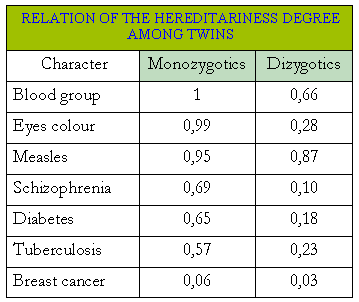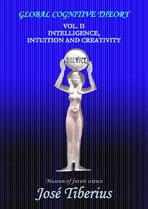4.c) Cognitive science and intelligence test
4.c.1. Hereditary versus predetermination
It is imperative to stress that having an innate intelligence or any other character does not mean following a hereditary linear ratio or a predetermination of a value. The combination of genes offers a wide array of possibilities.
The pink flowers may have red, pink, or white descendants in the typical examples of Mendel's laws.
The chart relating to the concordance in identical twins and just twin brothers can help to see the difference.
versus predetermination

The comparison between these percentages of concordance not only allows to differentiate between hereditary character and its predetermination correctly but also to deduce information about the number of chromosomes involved and possible different expressions or characteristics.
For example, the blood group depends on just one chromosome while schizophrenia depends on various, possibly six or seven, although it is difficult to know with just this information. Similarly, for schizophrenia, the heritability of parents to children is very low even though it has a genetic concordance of 69%
The concordance of intelligence is not on the table because it varies with different studies. Although from The EDI Study, it appears to be on one chromosome.
4.c.2. Multiple functions and facets of intelligence
Another problem is the definition of intelligence. Multiple functions and operatives modes configuring the cognitive processes affect the ability of measurement of an intelligence test.
However, the fact that intelligence is a group of elemental faculties does not mean they cannot be hereditary brain functions. Furthermore, if it turns out that one group of them has this characteristic, they all will probably have it.
On the other hand, the lack of a generally accepted definition of intelligence is inconvenient. Even so, a way of avoiding this byzantine discussion is to reverse the concept: the study on the heritability of reasoning will understand it as a group of intellectual faculties measured by a typical intelligence test.
Afterward, it will appear the analyses of the results of The EDI Study compared with standard results.
4.c.3. Continuous variable
Intelligence is a continuous variable of nature, which complicates the quantitative research of its heritability.
Typically, studies perform the treatment of continuous variables as a sum of more elemental and discreet ones. In general, the change of continuous variables is not readily compatible with variations by random mutations.
Intelligence can be like a sum of relational functions such as above/below, larger/smaller, general/specific. Although the appearance of a new relationship could be due to accidental causes, the improvement or greater precision in reasoning could turn out to be a little incomprehensible.
4.c.4. Cognitive ability test
There are two big problems when measuring intellectual abilities. The first comes from the fact that the display of these brain functions depends on the time of the day.
Tiredness, moods, and other various factors can significantly affect their expression from one day to the next or between the beginning and end of the same day.
The second one, each measurement uses a specific test, and the results can vary according to whether the individual has done a similar ability test in the past, the individual's personality or cultural affinity. However, if the design is adequate, this aspect should be minor.
In the quantitative data used from the longitudinal Young Adulthood study for the statistical analysis included in the EDI Study, the correlations between the different measurements of the same children of intellectual abilities are very low. The maximum is 33% even though they refer to the same people.
A simple conclusion would be to think that the brain functions of intelligence are not stable throughout life and that they highly fluctuate with the environment. However, some experts believe that intellectual abilities are incredibly durable throughout life, especially from 6 years of age on.
Common language, as an expression of the collective unconscious, clearly shows that intelligence is a fixed quality while referring to permanent characteristics in phrases such as that person is brilliant or knowledgeable. Well, at least in Spanish, this aspect is visible.
